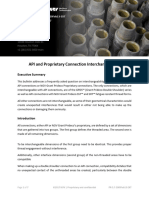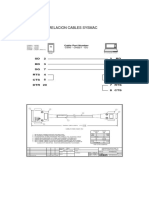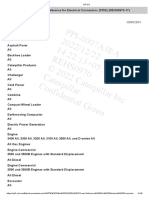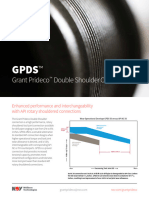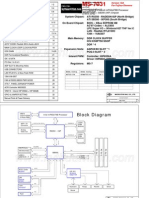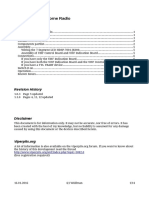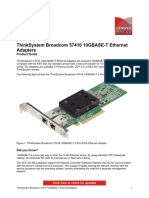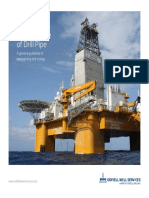D6B1004410 MKT 001
D6B1004410 MKT 001
Uploaded by
Janderson Sanchez CastañedaCopyright:
Available Formats
D6B1004410 MKT 001
D6B1004410 MKT 001
Uploaded by
Janderson Sanchez CastañedaOriginal Title
Copyright
Available Formats
Share this document
Did you find this document useful?
Is this content inappropriate?
Copyright:
Available Formats
D6B1004410 MKT 001
D6B1004410 MKT 001
Uploaded by
Janderson Sanchez CastañedaCopyright:
Available Formats
Product Bulletin PR-7.
6-2007Jan26-EXT
Rev. 6 – 29 March 2018
Grant Prideco™
NOV Wellbore Technologies
Product Management Dept.
10100 Houston Oaks Dr.
Houston, TX 77064
+1 (281) 921-3600 main
nov.com/grantprideco/
GPDS™ and API Interchangeability and Transition Point
Connecting a Grant Prideco™ Double Shoulder connection, referenced hereafter as GPDS, to the
API connection it is interchangeable to, may introduce a weak point in your drill string as the
double shoulder connection could be streamlined. However, if this limitation is seen as an issue,
it could easily be overcome.
Design Consideration
Grant Prideco has designed GPDS connections to be fully interchangeable with API connections
of similar size. Please refer to table 1 in appendix for reference on the interchangeability. Further
details on this interchangeability could be found in another product bulletin (PR-5.XX-2009Feb13-
EXT).
Let us first start with considerations on double shoulder connections and the possible
streamlining that engineers could use when optimizing the drill stem products design. Figure 1
illustrates the cross sectional view of typical double-shouldered connection. Its secondary torque
shoulder provides increased torsional capacity compared to a standard API rotary shoulder
connection; across drill pipe sizes GPDS connections show a 33 to 71% maximum make up torque
increase over API connection, with similar tool joint outside and inside diameters.
In most cases, this torque requirement exceeds driller’s need and connections are often
streamlined. Internal diameter is typically enlarged to improve hydraulic performances of the
drill pipe assembly. The outside diameter could also be reduced to improve the fishability and
reduce impact on ECD.
Page 1 of 6 ©2018 NOV | Proprietary and confidential PR-7.6-2007Jan26-EXT
It is important to note that when connecting streamlined GPDS™ with API rotary-shouldered
connections the make-up torque and torsional strength will be affected for two reasons:
• The secondary shoulder, or torque shoulder, will not engage.
• The torsional characteristic of the connection association is a result of the actual
connection pin internal diameter (ID) and box outside diameter (OD) at interface point.
Please refer to the tables 2 to 6 for actual torsional values applicable to the various configurations
(API to API, GPDS to GPDS, and GPDS to API) for GPDS sizes 31, 38, 40, 50 and 55. For other sizes
or other tool joint OD/ID configurations, please enquire from Grant Prideco technical marketing
group.
It is essential to understand that the make-up torque value can be different and that the right
torque shall be applied at every connection interface. In particular, one should understand that
the weakest point may be when connecting a GPDS pin (with a large ID) into an API box that is
normally connected to an API pin with a smaller ID.
Example:
If the string is mixing drill pipe with NC 38 connections (5” OD x 2 1/8” ID) with the interchangeable
GPDS 38 (5” x 2 7/16”), the maximum make up torque (MUT) for the API to API connection is
15,900 ft-lb. The GPDS 38 to GPDS 38 is rated at 17,500 ft-lb. However, the GPDS 38 pin to NC 38
box has a maximum MUT of 13,200 ft-lb. See yellow highlighted cells in the table 3 below.
How to avoid the weak point in your string
If the reduction of make-up torque at the interface point is an issue, we recommend keeping the
GPDS and API pipe in different sections of the string and not mixing them randomly. Since the
GPDS connection would typically deliver higher torque, this pipe would more likely be at the top
of the string. The “weak point” at the interface could easily be eliminated by using one crossover
sub (GPDS box up x API pin down) between the drill pipe sections, cut in a material having the
same specified minimum yield strength as the pipe tool joints.
Note that subs cut in raw material matching API Specification 7 for drill stem subs have properties
that are different from those of drill pipe tool joints and generally come with a lower material
specified minimum yield strength (SMYS), which would reduce the torsional properties of
connections accordingly.
Example:
With the above example, we would not have the connection association that was bringing the
lowest MUT of 13,200 ft-lb anymore. If the sub uses a material with a SMYS of 120,000 PSI, the
Page 2 of 6 ©2018 NOV | Proprietary and confidential PR-7.6-2007Jan26-EXT
string connection rating becomes 17,500 ft-lb in the GPDS™ 38 top connection, down to the cross
over sub upper connection, and then 15,900 ft-lb in the NC 38 drill pipe subsequent section. If
using a material to API Specification 7, the SMYS would be 110,000 PSI leading to a rating of
16,000 ft-lb in the upper part of the string and 14,600 ft-lb for the lower one.
Please do not hesitate to contact Grant Prideco™ representative for further data relating to the
connections you wish to use.
Conclusions
It is important to be aware of the consequences of mixing interchangeable connections together,
to avoid creating torsional weak points at connection transition.
If this torsional “weak” point is seen as a limiting factor, an easy mitigation consists of keeping
the various connections (GPDS and API rotary shouldered connections) in separate sections of
the string and using a crossover sub at the interface with appropriate yield properties.
Page 3 of 6 ©2018 NOV | Proprietary and confidential PR-7.6-2007Jan26-EXT
Appendices
Table 1 – GPDS™ to API connection interchangeability
GPDS™ API Obsolete Connection
GPDS 26 NC 26 2 3/8 IF – 2 7/8 SH
GPDS 31 NC 31 2 7/8 IF – 3 1/2 SH
GPDS 38 NC 38 3 1/2 IF – 4 1/2 SH
GPDS 40 NC 40 4 FH – 4 1/2 DSL
GPDS 46 NC 46 4 IF – 4 1/2 XH
GPDS 50 NC 50 4 1/2 IF – 5 1/2 DSL – 5 XH
GPDS 55 5 1/2 FH -
GPDS 65 6 5/8 FH -
Table 2 – Maximum Recommended MUT (ft-lb) for GPDS 31 to NC 31 associations
GPDS 31 Pin NC 31 Pin
2.000” ID 1.625” 2.000” ID 2.125” ID
GPDS 31 Box 4.125” OD 10,300 10,100 7,900 7,100
4.125” OD 7,900 8,500 7,900 7,100
NC 31 Box
4.375” OD 7,900 10,100 - -
Legend (Tables 2-6)
API to API
API Pin to GPDS™ Box or GPDS™ Pin to API Box
GPDS™ to GPDS™
Common Configurations
- Connection is dangerously (box or pin) weak! Not applicable. Ask Grant Prideco representative for further details
Table 3 – Maximum Recommended MUT (ft-lb) for GPDS 38 to NC 38 associations
GPDS 38 Pin NC 38 Pin
2.438” ID 2.563” ID 2.125” 2.438” ID 2.563” ID
4.750” OD - 14,900 - 11,500 11,500
GPDS 38 Box 4.875” OD 17,400 - 13,700 13,200 12,100
5.000” OD 17,400 15,400 15,900 13,200 12,100
4.750” OD 11,500 11,500 - 11,500 11,500
NC 38
4.875” OD 13,200 12,100 - 13,200 12,100
Box
5.000” OD 13,200 12,100 15,900 13,200 12,100
Note: See Legend below Table 2
Page 4 of 6 ©2018 NOV | Proprietary and confidential PR-7.6-2007Jan26-EXT
Table 4 – Maximum Recommended MUT (ft-lb) for GPDS 40 to NC 40 associations
GPDS 40 Pin NC 40 Pin
2.563” ID 2.688” ID 2.563” ID 2.688” ID
GPDS 40 Box 5.250” OD 21,800 19,600 16,600 15,300
NC 40 Box 5.250” OD 16,600 15,300 16,600 15,300
Note: See Legend below Table 2
Table 5 – Maximum Recommended MUT (ft-lb) for GPDS 50 to NC 50 associations
GPDS 50 Pin NC 50 Pin
3.000” ID 3.250” ID 3.500” ID 2.750” 3.250” ID 3.500” ID
GPDS 50 Box 6.625” OD 49,600 43,000 35,900 38,000 30,700 26,700
6.500” OD 34,200 30,700 26,700 34,200 30,700 26,700
NC 50 Box
6.625” OD 34,500 30,700 26,700 38,000 30,700 26,700
Note: See Legend below Table 2
Table 6 – Maximum Recommended MUT (ft-lbs) for GPDS 55 to 5 1/2 FH associations
GPDS 55 Pin 5 1/2 FH Pin
3.500” ID 3.750” ID 4.000” ID 3.125” ID 3.250” ID 3.500” ID 4.000” ID
GPDS 55 7.000” OD 55,800 52,200 43,800 37,700 37,700 37,700 33,400
Box 7.250” OD 61,200 52,700 43,700 47,200 47,200 43,300 33,400
7.000” OD 37,700 37,700 33,400 - - 37,700 33,400
5 1/2 FH
7.250” OD 43,300 38,500 33,400 47,200 47,200 43,300 33,400
Box
7.500” OD 43,300 38,500 33,400 50,000 47,800 - -
Note: See Legend below Table 2
Page 5 of 6 ©2018 NOV | Proprietary and confidential PR-7.6-2007Jan26-EXT
Figure 1 – Double Shoulder Connection
Author Marketing & Product Management G. Plessis
Approval Marketing & Product Management G. Plessis
Page 6 of 6 ©2018 NOV | Proprietary and confidential PR-7.6-2007Jan26-EXT
You might also like
- Engine Simulator Board V1.4 ManualDocument7 pagesEngine Simulator Board V1.4 ManualKi Rekso Aljero60% (5)
- 10 Drill String DesignDocument102 pages10 Drill String DesignDanian Primasatrya100% (2)
- SOP For Drilling OperationDocument288 pagesSOP For Drilling Operationyasirism100% (12)
- Drill USA: TEL: 713-594-7447 Rocksprings, TexasDocument4 pagesDrill USA: TEL: 713-594-7447 Rocksprings, Texashrh_pogcNo ratings yet
- About The Device/PLC Connection ManualsDocument7 pagesAbout The Device/PLC Connection ManualsDenisNo ratings yet
- API and Proprietary Connection Interchangeability: Executive SummaryDocument8 pagesAPI and Proprietary Connection Interchangeability: Executive SummaryDNo ratings yet
- API and Proprietary Connection Interchangeability.Document7 pagesAPI and Proprietary Connection Interchangeability.Levina AriestaNo ratings yet
- Efat1 1bDocument8 pagesEfat1 1bbilalshahid2338No ratings yet
- Description Features: PT6967 LED Driver ICDocument22 pagesDescription Features: PT6967 LED Driver ICDhivya NNo ratings yet
- Launchpad f28027ptt Pinout PDFDocument2 pagesLaunchpad f28027ptt Pinout PDFNathanael Günter PrangeNo ratings yet
- 75 CC 88Document7 pages75 CC 88Briliant ImronNo ratings yet
- Omron CablesDocument13 pagesOmron CablescomantonioNo ratings yet
- Design TorqueDocument7 pagesDesign Torqueaziz yandar wiradhikaNo ratings yet
- About The Device/PLC Connection ManualsDocument10 pagesAbout The Device/PLC Connection Manualshitesh sanchaniyaNo ratings yet
- Cavendish Manual pg1p1Document9 pagesCavendish Manual pg1p1naudjeremyNo ratings yet
- Mixed Signal Microcontroller: FeaturesDocument70 pagesMixed Signal Microcontroller: Featureslordrichard117No ratings yet
- Cavendish ManualDocument6 pagesCavendish ManualbertosamNo ratings yet
- Caterpillar Engine ConnectorsDocument146 pagesCaterpillar Engine ConnectorsB E BalaramenterpriseNo ratings yet
- Cable - Processor PinoutsDocument12 pagesCable - Processor PinoutsHanks EpphNo ratings yet
- ET6202 EtekMicroelectronicsDocument14 pagesET6202 EtekMicroelectronics9645564818tabNo ratings yet
- Philips Chassis Tpm5.2e-LaDocument59 pagesPhilips Chassis Tpm5.2e-Larolandas1970No ratings yet
- 10 Aaa25300akDocument12 pages10 Aaa25300akkędzierzawy100% (1)
- Delta PLC ManualDocument7 pagesDelta PLC ManualRoyal Ritesh SharmaNo ratings yet
- Gp-Pro/Pb PLC Connection ManualDocument24 pagesGp-Pro/Pb PLC Connection ManualCristhian Garcia VillarroelNo ratings yet
- DG408-DG409 Datasheet PDFDocument12 pagesDG408-DG409 Datasheet PDFCarlos IbaNo ratings yet
- D6B1004499-MKT-001Document2 pagesD6B1004499-MKT-001Mohammad Ridlwan NoorNo ratings yet
- GPDSDocument2 pagesGPDSben_jones72No ratings yet
- Electrical Connector GuideDocument91 pagesElectrical Connector Guideeric282000No ratings yet
- Package Information Including Surface Mount: Fast and Ls TTLDocument14 pagesPackage Information Including Surface Mount: Fast and Ls TTLMilka RamirezNo ratings yet
- Bill of QuantityDocument4 pagesBill of Quantityjibran97No ratings yet
- PHILIPS - 42PFL4506H Chassis TPM7.1E LA PDFDocument83 pagesPHILIPS - 42PFL4506H Chassis TPM7.1E LA PDFTestrooteNo ratings yet
- DIN 43650-ConnectorsDocument10 pagesDIN 43650-ConnectorsDiego GranadosNo ratings yet
- Transistor Power MOSFETs in DPAK 5N52SUDocument19 pagesTransistor Power MOSFETs in DPAK 5N52SUHERNANDO A BECERRANo ratings yet
- Maiboard Msi - 7031Document31 pagesMaiboard Msi - 7031Ho Thanh BinhNo ratings yet
- ACER Aspire1600Document10 pagesACER Aspire1600rapazdosnotesNo ratings yet
- RFD8P05 Datasheet (PDF) - Intersil CorporationDocument6 pagesRFD8P05 Datasheet (PDF) - Intersil Corporationrcuvgd-1No ratings yet
- CWG - Material Check ListsDocument6 pagesCWG - Material Check ListsHeartcare CentreNo ratings yet
- Yorkville Ap2020 Power Amplifier Service ManualDocument10 pagesYorkville Ap2020 Power Amplifier Service ManualEsmir MarinNo ratings yet
- EcomhdyaDocument24 pagesEcomhdyaMohamed BelliliNo ratings yet
- 10 Aaa21305caDocument25 pages10 Aaa21305cakędzierzawyNo ratings yet
- Control LED Drive Circuit: FeaturesDocument14 pagesControl LED Drive Circuit: FeaturesJacksonVelozNo ratings yet
- 018 0318 QT EO PT Indo Green Power PCDocument2 pages018 0318 QT EO PT Indo Green Power PCAdhie DaeslerNo ratings yet
- PD6379, 6379A, 6379L, 6379AL: Mos Integrated CircuitDocument16 pagesPD6379, 6379A, 6379L, 6379AL: Mos Integrated CircuitСергей КолосовNo ratings yet
- Controller Model: Maple OIT Model: Communication Type: RS-422 With 8 Pin Connector at PLCDocument1 pageController Model: Maple OIT Model: Communication Type: RS-422 With 8 Pin Connector at PLCMoumene Djafer BeyNo ratings yet
- Proface PLCs Ethernet Communication PDFDocument17 pagesProface PLCs Ethernet Communication PDFRata IonNo ratings yet
- Elec SPM CH04 F01Document2 pagesElec SPM CH04 F01litoral.agropecuariaNo ratings yet
- KL25Z FirmwareDocument16 pagesKL25Z FirmwareSagar AddepalliNo ratings yet
- UHF Quickstart 1 1 0Document14 pagesUHF Quickstart 1 1 0ZDENDA EDITZNo ratings yet
- Proface PLCs 1 - 1 Connection - 1 - N Connection PDFDocument35 pagesProface PLCs 1 - 1 Connection - 1 - N Connection PDFRata IonNo ratings yet
- Industrial DIN Rail Mounted RS-422/485 Line Isolator/RepeaterDocument4 pagesIndustrial DIN Rail Mounted RS-422/485 Line Isolator/RepeaterÁgost VitaNo ratings yet
- Proposed Complete Renovation ofDocument5 pagesProposed Complete Renovation ofAbdulyekini AhmaduNo ratings yet
- Thinksystem Broadcom 57416 10Gbase-T Ethernet Adapters: Product GuideDocument18 pagesThinksystem Broadcom 57416 10Gbase-T Ethernet Adapters: Product GuidedoegoodNo ratings yet
- P366e6088g C NTSN1413 1.3 VerDocument46 pagesP366e6088g C NTSN1413 1.3 Verteo gonzalezNo ratings yet
- Main Cabin Mini2 DIP 03-08-11Document12 pagesMain Cabin Mini2 DIP 03-08-11tohid_ccNo ratings yet
- Maratel Home PR Eod Nov 28Document30 pagesMaratel Home PR Eod Nov 28rlaporreNo ratings yet
- Harnes Assembley IVDocument109 pagesHarnes Assembley IVroberto jose vergara gilNo ratings yet
- Pioneer vsx-524-k vsx-5241 Av Receiver rrv4533 Parts SMDocument4 pagesPioneer vsx-524-k vsx-5241 Av Receiver rrv4533 Parts SMImraan Ramdjan50% (2)
- Hardware Billing SystemDocument2 pagesHardware Billing SystemAnsilNo ratings yet
- Recommended Spark PlugsDocument3 pagesRecommended Spark PlugsDjebali MouradNo ratings yet
- Mb52 26 Febrero 2024Document4 pagesMb52 26 Febrero 2024xmr7954No ratings yet
- Physics and Technology of Crystalline Oxide Semiconductor CAAC-IGZO: Application to LSIFrom EverandPhysics and Technology of Crystalline Oxide Semiconductor CAAC-IGZO: Application to LSINo ratings yet
- Radio Shack TRS-80 Expansion Interface: Operator's Manual Catalog Numbers: 26-1140, 26-1141, 26-1142From EverandRadio Shack TRS-80 Expansion Interface: Operator's Manual Catalog Numbers: 26-1140, 26-1141, 26-1142No ratings yet
- Introduction To Drilling: School of Hassi MessaoudDocument210 pagesIntroduction To Drilling: School of Hassi MessaoudbeyNo ratings yet
- Vulcan Thread BecoDocument12 pagesVulcan Thread Becos_barrios100% (1)
- Cementing and Pumping - COMMERCIAL TEMPLATEDocument9 pagesCementing and Pumping - COMMERCIAL TEMPLATEjeedanNo ratings yet
- Analytical Model For BHADocument13 pagesAnalytical Model For BHALeandro NavarroNo ratings yet
- Rabi3a Old Edittion 1985 Cairo University 2nd Petroleum 16Document319 pagesRabi3a Old Edittion 1985 Cairo University 2nd Petroleum 16Abdelaziz Mohamed Abdelmoaty Arafa100% (2)
- DS-1 Vol. 3 Table 2.1-2.2 Fig. 2.7 To 2.12Document11 pagesDS-1 Vol. 3 Table 2.1-2.2 Fig. 2.7 To 2.12Chandrasekhar Sonar100% (1)
- Plug-Back CementingDocument14 pagesPlug-Back CementingAli AliievNo ratings yet
- OctgDocument36 pagesOctgWaleed Barakat MariaNo ratings yet
- Double Sided Product Flier 2017-05-10 (2 Pages)Document2 pagesDouble Sided Product Flier 2017-05-10 (2 Pages)delcololalunaNo ratings yet
- 1 Intro To DrillingDocument132 pages1 Intro To DrillingEric FamacyNo ratings yet
- Chapter 2 - Hole Problem March 2018 PDFDocument60 pagesChapter 2 - Hole Problem March 2018 PDFMohd RafiqNo ratings yet
- Inspection and Maintenance of Drillpipe E-BookDocument39 pagesInspection and Maintenance of Drillpipe E-BookRichard More Leon100% (3)
- Command Smfi Catalog 2020 DP SpecsDocument59 pagesCommand Smfi Catalog 2020 DP SpecsMile SikiricaNo ratings yet
- Making Connections With The Kelly: Cormorant Alpha Drilling Operations GuideDocument10 pagesMaking Connections With The Kelly: Cormorant Alpha Drilling Operations GuidealiNo ratings yet
- Tri Can HandbookDocument407 pagesTri Can HandbookIMEDHAMMOUDA100% (1)
- 22 CompleteWellSummaryDocument4 pages22 CompleteWellSummaryDavide BoreanezeNo ratings yet
- Otc-28824-Ops and Safety Improvements of Applying Real-Time Analytics in RTOCDocument14 pagesOtc-28824-Ops and Safety Improvements of Applying Real-Time Analytics in RTOCmbkh7117No ratings yet
- Omsco Drillpipe CatalogueDocument24 pagesOmsco Drillpipe Cataloguerwinmill100% (3)
- 5 - Volumes & MaaspDocument111 pages5 - Volumes & Maaspsouthernor100% (2)
- Drilling Data HandbookDocument495 pagesDrilling Data HandbookGenise Noel100% (5)
- SPE MPD PresentationDocument37 pagesSPE MPD Presentationchirag.rathi100% (1)
- The Drill String Is Connecting The Drill Bit On Bottom To The SurfaceDocument3 pagesThe Drill String Is Connecting The Drill Bit On Bottom To The SurfaceRUDDYNo ratings yet
- 4.000 S135 XT39 Drill Pipe Rental Saltire EnergyDocument3 pages4.000 S135 XT39 Drill Pipe Rental Saltire Energyr.cruzNo ratings yet
- Comparison of Field and Laboratory-Simulated Drill-Off TestsDocument6 pagesComparison of Field and Laboratory-Simulated Drill-Off TestsAhmed Ali AlsubaihNo ratings yet
- Drill-Pipe PipeBody at 80%, 5.875in, 0.361wall, IEUDocument9 pagesDrill-Pipe PipeBody at 80%, 5.875in, 0.361wall, IEUFernando Ruiz ArroyoNo ratings yet
- Drill Pipe Performance SheetDocument3 pagesDrill Pipe Performance Sheetjinyuan74No ratings yet
- DownloadDocument12 pagesDownloaddjabercopywirterNo ratings yet






